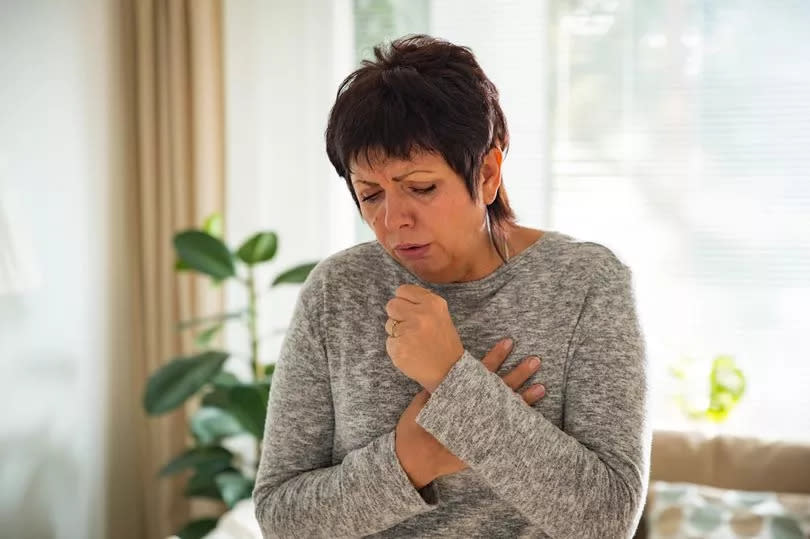If you're coughing a lot at home there could be an unexpected reason

Experts have explained an unexpected reason why you might be coughing a lot at home - particularly in the kitchen. The common yet often underestimated kitchen hazard that could lead to serious coughing is poor ventilation, particularly when cooking, they said.
Bathroom and kitchen experts Plumbworld said everyday cooking activities could impact indoor air quality and potentially lead to respiratory issues. Here's why.
Concentration of cooking emissions: In the UK, kitchens are often compact, which can exacerbate the problem of poor ventilation. Cooking produces a variety of emissions, including steam, grease particles, and smoke, especially when frying or using high-heat cooking methods. Without adequate ventilation, these particles can linger in the air, where they become irritants to the lungs and throat, often triggering coughing as the body tries to expel them.
Accumulation of harmful gases: Gas stoves, which are common in UK homes, can emit nitrogen dioxide and carbon monoxide. Both of these gases can be harmful to human health, particularly when they accumulate in an unventilated kitchen. Chronic exposure to low levels of these gases can lead to respiratory symptoms, including coughing and wheezing, and may exacerbate conditions such as asthma and chronic obstructive pulmonary disease (COPD).
Mould and damp Issues: The UK's generally damp climate can contribute to the growth of mould and mildew in kitchens, particularly in areas with inadequate ventilation. Mould spores are known allergens and irritants, capable of causing persistent coughs and other respiratory symptoms when inhaled. Ensuring good airflow helps reduce humidity levels, thus inhibiting mould growth and improving air quality.
Interaction with cleaning chemicals: Cleaning products commonly used in kitchens contain chemicals such as ammonia and bleach. These substances can release volatile organic compounds (VOCs), which are respiratory irritants. In a poorly ventilated kitchen, VOCs can accumulate to levels that can cause irritation to the eyes, nose, throat, and lungs, leading to coughing and other respiratory issues.
Enhancement of indoor allergen effects: Kitchens often accumulate common indoor allergens like pet dander, pollen, and dust mites. In poorly ventilated spaces, these allergens can reach higher concentrations and become more problematic, particularly for individuals with allergic respiratory conditions like asthma. The limited air exchange exacerbates the impact of these allergens, increasing the likelihood of coughing and respiratory distress.
How to deal with poor ventilation
Install adequate ventilation systems: Utilising extractor fans and ensuring they vent to the outside rather than recirculating the air within the kitchen is crucial. This practice is especially important in smaller UK kitchens where airspace is limited.
Regular maintenance: Keeping ventilation systems clean and in good working order is vital. This includes cleaning filters and checking for blockages or mechanical issues that could reduce their efficiency.
Use of air purifiers: For additional air quality improvement, particularly in urban areas or during high pollen seasons, using an air purifier with a HEPA filter can help reduce particulate matter and airborne allergens indoors.
Behavioural adjustments: Simple changes, such as opening windows during and after cooking, using lids on pans to minimise moisture release, and reducing the use of harsh chemical cleaners, can significantly improve kitchen air quality.
A spokesperson from Plumbworld said: “To ensure that your kitchen remains a safe and healthy space without overspending, consider using fans strategically during and after cooking. Positioning a standard fan to blow unwanted air out of a window can be an effective way to enhance circulation and reduce indoor pollutants. This method can be particularly cost-effective as it repurposes items you may already have at home, eliminating the need for immediate investment in new appliances.
"It's also wise to keep your cooking practices in check to minimise harmful emissions. Opt for cooking methods that produce less smoke, such as steaming or baking, rather than frying or grilling. This not only helps maintain cleaner indoor air but also reduces the strain on your ventilation system, potentially lowering maintenance costs over time. Keeping your kitchen environment clean and minimising high-emission cooking techniques can have a substantial impact on both air quality and your budget.”

 Yahoo News
Yahoo News 
